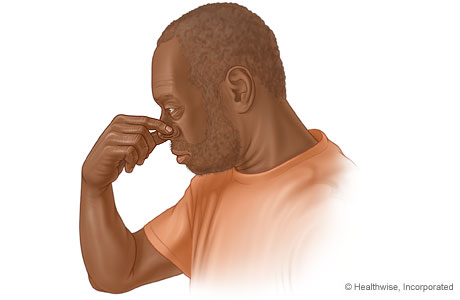Stopping a Nosebleed
Topic Overview
Most nosebleeds occur in the front of the nose and involve only one nostril. Some blood may drain down the back of the nose into the throat. These nosebleeds typically are not serious, and you can generally treat them yourself at home.
A less common but more serious type of nosebleed starts in the back of the nose and often involves both nostrils. Large amounts of blood may run down the back of the throat. This type of nosebleed may occur more frequently in older adults because of health conditions they may have. You will need treatment from a doctor to control bleeding from this type of nosebleed.

Stopping a nosebleed
Follow these steps to stop a nosebleed:
- Sit up straight and tip your head slightly forward.
- Note: Do not tilt your head back. This may cause blood to run down the back of your throat, and you may swallow it. Swallowed blood can irritate your stomach and cause vomiting. And vomiting may make the bleeding worse or cause it to start again. Spit out any blood that gathers in your mouth and throat rather than swallowing it.
- Use your thumb and forefinger to firmly pinch the soft part of your nose shut. The nose consists of a hard, bony part and a softer part made of cartilage. Nosebleeds usually occur in the soft part of the nose. Spraying the nose with a medicated nasal spray (such as Afrin) before applying pressure may help stop a nosebleed. You will have to breathe through your mouth.
- Keep pinching for a full 10 minutes. Use a clock to time the 10 minutes. It can seem like a long time. Resist the urge to peek after a few minutes to see if your nose has stopped bleeding.
- Check to see if your nose is still bleeding after 10 minutes. If it is, hold it for 10 more minutes. Most nosebleeds will stop after 10 to 20 minutes of direct pressure.
- Put a thin layer of a saline- or water-based nasal gel, such as NasoGel, or an antiseptic nasal cream inside your nose. Do not blow your nose or put anything else inside your nose for at least 12 hours after the bleeding has stopped.
- Rest quietly for a few hours.
Preventing nosebleeds
After you have stopped a nosebleed, the following tips may prevent a nosebleed from happening again:
- Avoid forceful nose-blowing.
- Do not pick your nose.
- Avoid lifting or straining after a nosebleed.
- Elevate your head on pillows while sleeping.
- Put a thin layer of a saline- or water-based nasal gel, such as NasoGel, or an antiseptic nasal cream inside your nose.
- Do not use aspirin or other nonsteroidal anti-inflammatory drugs (NSAIDs) such as ibuprofen or naproxen for 3 to 4 days. Acetaminophen, such as Tylenol, may be used to relieve pain. Be safe with medicines. Read and follow all instructions on the label. Talk to your doctor about stopping any medicines you are currently taking.
- Do not use nonprescription antihistamines, decongestants, or medicated nasal sprays.
Nosebleeds may develop in people who have colds or chronic hay fever symptoms (postnasal drip, sneezing, or a runny, stuffy, or itchy nose) because nasal tissues become inflamed and irritated. Using medicines may relieve the symptoms, leading to less inflammation and irritation and fewer nosebleeds. But overuse of allergy medicines may lead to nosebleeds because of their overdrying side effects. If you have a lot of nosebleeds, talk to your doctor about the proper use of cold and allergy medicines.
If you are helping someone else stop a nosebleed, avoid touching the other person’s blood. Use gloves, if available, or layers of fabric or a plastic bag to protect yourself.
Current as of: June 26, 2019
Author: Healthwise Staff
Medical Review:William H. Blahd, Jr., MD, FACEP – Emergency Medicine & Adam Husney, MD – Family Medicine & Kathleen Romito, MD – Family Medicine
Topic Contents
This information does not replace the advice of a doctor. Healthwise, Incorporated, disclaims any warranty or liability for your use of this information. Your use of this information means that you agree to the Terms of Use. Learn how we develop our content.

